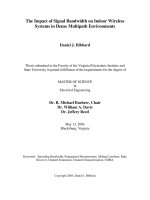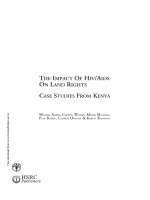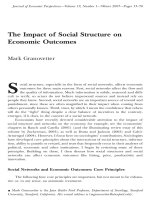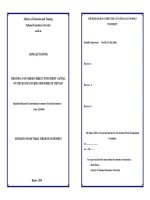THE IMPACT OF OWNERSHIP STRUCTURE ON CAPITAL STRUCTURE
Bạn đang xem bản rút gọn của tài liệu. Xem và tải ngay bản đầy đủ của tài liệu tại đây (1.56 MB, 81 trang )
MASTER THESIS
THE IMPACT OF
OWNERSHIP
STRUCTURE ON
CAPITAL
STRUCTURE
Evidence from listed firms in China
LingLing ZHANG
SCHOOL OF MANAGEMENT AND GOVERNANCE
FINANCIAL MANAGEMENT
SUPERVISORS
Dr. Xiaohong Huang
Prof.dr.Rezaul Kabir
10-09-2013
Abstract
This study examines the impact of ownership structure on capital structure of
non-financial Chinese listed firms from 2007 to 2012. Pooled OLS regression is used
to investigate the influence of ownership related variables on firm’s capital structure
decision. The independent variables include ownership concentration, managerial
ownership, state ownership and legal person ownership, controlling for the influence
of common firm-related variables and industry effects.
The significantly reversed U-shape nonlinear relation between ownership
concentration and capital structure suggests that there might be an optimal level of
ownership concentration. There is no evidence that managerial ownership affects
firm’s capital structure. The positive relation between state ownership and capital
structure confirms the role of state in firms’ corporate financing decisions, firms with
state ownership prefer issue more debt to resolve severe agency problem between
shareholders and managers. Besides, firms with state ownership access to bank loans
easier than firms without state ownership, as well as access to long-term loans. There
is a weak positive relation between legal person ownership and capital structure, the
highly correlation between state and legal person makes the result less reliable.
Acknowledgements
Firstly, I would like to express my greatest gratitude to Dr. Xiaohong Huang, my first
supervisor. She inspired me for the thesis construction, the timely discussion points
out imperfection and brings out critical comments to guide next step. Her broad
knowledge, strict scientific attitude and kind help have been benefited me a lot.
I also would like to thank Prof. dr. Rezaul Kabir, my second supervisor. He helps me
to improve the thesis framework and logic. His timely critical and valuable
comments make the thesis more precise and plentiful.
Especially, I want to thank one of my classmates, Xu Lu, she helps me to collet
crucial data.
I am thankful to my husband and my parents for their constant support and
encouragement. Finally, I appreciate the help from my friends in University of
Twente, your supports make me enjoy a happy and full study in the Netherlands.
Contents
1 Introduction .................................................................................................................................... 1
1.1 Background of the study ......................................................................................................... 1
1.2 Objective ................................................................................................................................. 3
1.3 Introduction to capital structure .............................................................................................. 4
1.4 The concept of corporate governance ..................................................................................... 5
1.5 Structure .................................................................................................................................. 6
2 Literature review and background in China ................................................................................... 9
2.1 Theoretical framework ............................................................................................................ 9
2.1.1 The agency theory ............................................................................................................ 9
2.1.2 Corporate governance and ownership structure ............................................................. 11
2.1.2.1 Ownership concentration....................................................................................... 12
2.1.2.2 Managerial ownership ........................................................................................... 13
2.1.2.3 Ownership identity ................................................................................................ 14
2.2 Corporate governance and ownership structure in China ..................................................... 15
2.2.1 Corporate governance practice ....................................................................................... 15
2.2.2 Ownership structure ....................................................................................................... 15
2.2.2.1 Ownership concentration....................................................................................... 17
2.2.2.2 Managerial ownership ........................................................................................... 19
2.2.2.3 State ownership ..................................................................................................... 19
2.2.2.4 Legal person ownership ........................................................................................ 20
3 Empirical evidence and hypotheses ............................................................................................. 21
3.1 Evidence from developed economies.................................................................................... 21
3.1.1 Ownership concentration ............................................................................................... 21
3.1.2 Managerial ownership .................................................................................................... 22
3.1.3 Ownership identity ......................................................................................................... 23
3.2 Evidence from developing economies .................................................................................. 23
3.2.1 Ownership concentration ............................................................................................... 23
3.2.2 Managerial ownership .................................................................................................... 24
3.2.3 Ownership identity ......................................................................................................... 25
3.3 Hypotheses development ...................................................................................................... 27
3.3.1 Ownership concentration ............................................................................................... 28
3.3.2 Managerial ownership .................................................................................................... 29
3.3.3 State ownership .............................................................................................................. 29
3.3.4 Legal person ownership ................................................................................................. 30
4 Data and methodology ................................................................................................................. 33
4.1 Data ....................................................................................................................................... 33
4.2 Research methodology .......................................................................................................... 34
4.2.1 Regression model ........................................................................................................... 34
4.2.2 Variable measurement .................................................................................................... 35
4.2.2.1 Dependent variables .............................................................................................. 35
4.2.2.2 Independent variables............................................................................................ 36
4.2.2.3 Control variables ................................................................................................... 36
5 Empirical results .......................................................................................................................... 39
5.1 Descriptive statistics ............................................................................................................. 39
5.2 Empirical results ................................................................................................................... 45
5.3 Robustness tests .................................................................................................................... 50
6 Conclusion ................................................................................................................................... 59
6.1 Main research conclusion...................................................................................................... 59
6.2 Limitation and future research .............................................................................................. 61
Reference ........................................................................................................................................ 63
Appendix ......................................................................................................................................... 67
1 Introduction
1.1 Background of the study
Since the proposed Modigliani and Miller theory (Modigliani & Miller, 1958) in last
century, capital structure has been one of the most important topics in corporate
financial fields. Capital structure refers to the financing structure of the firm through
debt, equity and combination securities. The constitution of debt and equity reflects
the way firms seeking profit maximization. Thus, capital structure will markedly
influence firm value.
Capital structure theory studies firm’s financing structure and the factors influencing
capital structure. Bulk literatures focus on trade-off and pecking order theory to
explain firms’ debt financing decisions. These studies have already identified certain
key determinants of capital structure, such as firm size, growth opportunity,
profitability and tangible assets, etc. (Booth et al., 2001; Rajan & Zingales, 1995;
Titman & Wessels, 1988). Other than these common determinants, agency theory as
proposed by Jensen & Meckling (1976) argues that, agency costs arising from the
conflict of interests between managers and shareholders also influence firm’s capital
structure. Regarding to the well research of other two capital structure theories, this
study mainly focus on agency theory and try to find out agency costs related
determinants which influence firms’ capital structure decisions.
Corporate finance theories suggest that, agency cost influence capital structure
choice, while corporate governance aims to mitigate the agency problems (Hasan &
Butt, 2009). Thus the agency theory postulates the potential relationship between
capital structure and corporate governance structure through the connection with
agency costs. Corporate governance is used as manage and control system for the
corporation. According to modern capital structure theory, shareholders and creditors
provide funds for the corporation and control the company, while managers in fact
manage the company to maximize the value of shareholders. The different
preference and impact between managers and shareholders, as well as the interests of
1
different parties will influence the financing decision, and thus determine different
capital structure choice of the firm.
Corporate governance system could effectively govern and mitigate the corporate
conflicts between shareholders and mangers and between controlling shareholders
and minority shareholders through internal and external control mechanisms (Bai et
al., 2004). Internal controls aim to mitigate the conflicts between shareholders,
managers, board of directors and other stakeholders through surveillance and control
of management, which is under control of managers and shareholders within the
corporation. Among the internal governance mechanisms, ownership structure is
crucial. Shareholders exert influence on managers to reduce agency conflicts by
managing ownership structure (Bai, et al., 2004). External corporate governance
mechanisms focus on disciplining and monitoring roles outside of the firm, such as
market for corporate control (Ehikioya, 2008).
According to the requirement of corporate law of China, the corporate governing
structure of listed firms in China consists three parts, which are shareholders, board
of directors and board of supervisors (Kato & Long, 2006). Despite the similarity of
corporate structure with European countries and the United States, the ownership
structure of listed firms in China is significantly different with firms in those market
economies.
The most important feature of this concentrated ownership structure is the
dominance of government ownership (Sun & Tong, 2003). Most listed firms are
reorganized from state-owned enterprises (SOEs), after the IPO, the shares of listed
SOEs are essentially controlled by the government. Even after share split reform in
20051, the government still maintains its ownership control and influence the capital
structure choice of listed firms (Liu et al., 2011). Furthermore, the high level of
ownership concentration and low level of managerial ownership lead to sever agency
conflicts between managers and investors. With lower percentage of managerial
ownership, managers have no incentive to increase investor wealth and firm value,
but pursue personal benefits.
1
In 2005, China’s Securities Regulation Commission (CSRC) published the document of Split Share Structure
2
These distinctive characteristics illustrate the importance of corporate governance on
firm’s financial decisions. Moreover, corporate takeovers are nearly scarce in China,
thus market for corporate control is not used as a device for disciplining corporate
managers (Zhuang et al., 2000). Bhabra et al. (2008) argue the distinctive
characteristics of Chinese financial market that are related with corporate capital
structure choice, such as high information asymmetry, highly concentrated
ownership and a lack of external market for corporate control. Therefore, internal
corporate governance mechanism, to be specific, ownership structure is more crucial
for Chinese listed firms. While external control may be less influential. Based on
these arguments, it’s believed that the determinants of capital structure of Chinese
firms are consistent with the conventional theories but also driven by specific
Chinese characteristics (Moosa et al., 2011). The unique ownership structure of
Chinese listed firms makes it as important determinant to influence firm’s capital
structure.
1.2 Objective
In line with the above background, the primary objective of this study is to
investigate the impact of ownership structure on capital structure choice of listed
firms in China.
Despite the recent literatures discussing the impact of ownership structure on firm’s
capital structure, most studies investigate partial aspects of ownership structure.
Several literatures discuss the impact of ownership concentration and state
ownership, but neglect the managerial ownership. The reason is the relatively low
level of managerial ownership in Chinese listed firms. However, with the
development of corporate governance, managerial incentive has been important to
solve agency conflicts between management and investors. Institutional ownership
as an important part of influencing financial decisions is ignored by most literatures.
Therefore, this study will add value to introduce broad ownership structure factors
and their impacts on capital structure.
This study aims to find the most relative ownership structure related factors of
3
influencing capital structure of Chinese listed firms during 2007 to 2012. This study
uses annual data to investigate the impact of ownership concentration and the
identity of ownership structure, whichever in the hands of state, institutions or
families, and the impact of managerial ownership on capital structure decisions.
The following main research question can be formulated:
How does the ownership structure influence the capital structure choice of
listed firms in China?
In order to answer this research question, the following sub questions need to be
answered:
How can agency theory be used to explain capital structure?
To what extent could ownership structure influence capital structure?
1.3 Introduction to capital structure
Capital structure is the way a firm raising capital to support its operations and future
growth by using composition of debt and equity. Debt financing and equity
financing are two main capital sources in business. Firms issue more debt bear high
risk. An optimal capital structure should be the balance of debt and equity. Debt can
be classified as long term debt and short term debt, long term debt includes bonds,
long term loan and long-term notes payable. Short term debt consist short term bank
loan and account payable. Equity capital usually consist common stock, preferred
stock and retained earnings. Most firms employ the combination of debt and equity
to finance their assets to minimize costs of capital. The formed capital structure is
usually referred as leverage.
Leverage is the ratio of debt to total assets of the firm. Leverage reflects the
proportion of debt financing in total assets, and could be used to measure the level of
protection for creditors once the firm facing liquidation. High level of leverage
usually means that a firm takes aggressive strategy for financing its future growth by
issuing debt. This may increase firm’s earning volatility due to the arising interest
expense.
New businesses usually take certain amount of debt when raise capital. The common
form of debt is bank loan, firms issuing debt need to pay interest regularly and repay
4
principal in due. Firms can issue long term or short term debt according to their
financial strategy. Short term debt has maturity with or less than one year of
borrowing. Long term debt refers to the debt that is taken for 10 years or longer.
Regarding to equity, common stock is the shares possessed by common shareholders.
Common shareholders own the equity of the firm and have voting rights for the
control of important company matters. Common stock holders don’t have fixed
dividend and thus their income is highly uncertain and contingent with company
earning and market value. Like common shareholders, preferred shareholders receive
dividends from firm’s profits but have priority in the payment of dividend and upon
bankruptcy. Besides, preferred shareholders usually have no voting rights. Retained
earnings refer to the portion of profits that firm doesn’t distribute to shareholders but
are reserved for future investments.
In the point of creditors, leverage ratio is expected to be lower. Firms with lower
leverage generally have enough assets to repay debt and thus creditors bearing less
risk. If the total profits are higher than debt costs, shareholders obtain the increased
earnings. For this reason, shareholders would prefer higher level of leverage.
However, if the costs of debt financing exceed the returns of debt, it would cause
financial dilemma for the firm and eventually lead to bankruptcy, which leave
shareholders nothing. Firms raise too much funds from debt financing will increase
future financial risk. Creditors will require adequate collateral to assure their pay-off.
If risky investments fail, firm faces bankruptcy risk and creditors will take over the
operation. The optimal capital structure is to balance the costs of debt financing and
firm’s economic benefits and future development.
1.4 The concept of corporate governance
Corporate governance determines the target and direction of corporate operation.
The separation of ownership and control gives management powers to purse private
benefits with the expense of shareholders, which increases agency costs and
decreases economic efficiency. Corporate governance has been an important element
for managing corporate operation and improving economic efficiency. John and
5
Senbt (1998) state that corporate governance is effective control mechanism through
which firm’s stakeholders could exercise control over corporate insiders and
management to protect their interests. Firm’s stakeholders include shareholders and
creditors, as well as other stakeholders like employees and suppliers.
Corporate governance commits to resolve the agency problems which arising from
the separation of ownership and control. Effective corporate governance depends on
the combination of internal and external governance mechanisms (Bai, et al., 2004).
Internal governance aims to diminish the conflicts between management,
shareholders, board of directors and other stakeholders within the firm and in the
control of managers and shareholders of the corporation. The internal corporate
governance mechanisms include ownership structure which reflects the distribution
structure of corporate control, board structure like board size and board of
supervisors (Ehikioya, 2008). External governance depends on the public laws and
disciplining mechanism which exert influence to the board of directors, management
and firm operation from the outside of the corporation.
The common external governance includes product market competition, market
manager competition, market for corporate control and creditor monitoring
mechanism. An active market for corporate control is essential for the managers to
allocate resources efficiently (Bai, et al., 2004). Good corporate governance helps
firms to raise funds and guarantee the return of investments to capital providers. It
provides effective incentives, restrains and surveillance for managers to reduce
agency costs arising from moral hazard and adverse selection and maximize the
value of shareholder and the firm.
1.5 Structure
The thesis is structured as follows. Chapter 1 introduces the research question,
discussed the background, objective and structure of the study. Chapter 2 reviews the
agency theory and ownership structure, as well as and corporate governance practice
and ownership structure in China. Chapter 3 presents empirical evidence and
develop testable hypotheses. Chapter 4 describes the data and research methodology.
6
Chapter 5 presents the main empirical results and interpretation. Chapter 6
summarizes the conclusion of the study.
7
8
2 Literature review and background in China
Since the seminal work of Modigliani and Miller (1958), several major theories have
been developed to explain firms’ capital structure decisions. The trade-off theory,
pecking order theory and agency theory are three main theories to investigate capital
structure both in developed and developing countries. Extensive studies have already
investigated capital structure by using trade-off and pecking order theory, and show
quite consistent results. Thus this study focuses on agency theory to explain the
possible corporate conflicts and the impact on capital structure decisions 2 .
Meanwhile, theoretical framework about ownership structure is illustrated. And then
introduce the ownership related background situation in China.
2.1 Theoretical framework
2.1.1 The agency theory
The agency theory proposed possible conflicts of interest between related parties
when firms make financial decisions: conflicts between shareholders and managers,
and conflicts between shareholders and debt holders (Jensen, 1986; Jensen &
Meckling, 1976).
The agency theory postulates that agency costs arising from the conflict of interest
between corporate managers and shareholders, is due to the separation of ownership
and control. The conflict is a potential determinant of capital structure. This agency
costs is known as free cash flow hypothesis (Jensen, 1986). Corporate managers
possess substantial free cash flow tend to increase resources under their control and
invest in low return projects but not distributing to shareholders. Firms could change
capital structure to solve this agency problem. To be specific, increase leverage level
to constraint management activities. If the firm has expected future growth
opportunities, debt obligation helps to limit the overinvestment of free cash flow.
Debt could also be used to indicate management’s willingness to pay out cash flows
(Harvey et al., 2004). Increased debt forces managers to pay future excess free cash
2
See appendix for the brief review of the trade-off theory and pecking order theory
9
flows for interest and repayment. Thus, firms reduce agency costs of free cash flow
through debt. Besides, high level of debt increases the bankruptcy risk if firm
couldn’t repay debt in time. The potential bankruptcy costs force managers to work
hard to make valuable investment decisions, and consequently reduce the risk of
bankruptcy (Grossman & Hart, 1980).
Another potential conflict arises between shareholders and debt holders which
causes agency costs of debt financing (Jensen & Meckling, 1976). Firstly,
shareholders may choose to invest high risk projects to maximize returns of
shareholders but damage the benefits of debt holders. When the investment
successfully receives profits against the debt, shareholders capture most of extra
benefits. However, debt holders undertake the failure costs if investment is failed. As
a result, shareholders might benefit from investing risky projects even if they are
value decreasing (Harris & Raviv, 1991). Secondly, as Myers (1977) discussed,
when firms have high amount of debt, the expected benefits of investing projects
will be used to repay debt. Thus, shareholders will lack incentives to support these
investments or invest suboptimally.
Similarly, corporate governance literatures also stress the conflict of interests
between large controlling shareholders and minority shareholders (Hasan & Butt,
2009; Liu, et al., 2011; Shi, 2010). The expropriation hypothesis suggests that, with
concentrated ownership, large controlling shareholders expropriate wealth from
minority shareholders, with the expense of minority shareholders (Shleifer & Vishny,
1997). This conflict would decrease firm value.
When firm uses debt financing, it decreases the conflicts of interest between
managers and shareholders, but increases the conflicts between shareholders and
debt holders. Thus the agency theory states that the optimal capital structure of the
firm could be determined by minimizing the possible agency costs arising from
stakeholders involved conflicts.
10
2.1.2 Corporate governance and ownership structure
Generally, there are two levels to discuss ownership structure. The first one is the
percentage of shares held by first largest or first five largest shareholders, which
indicates the concentration level of ownership. The second aspect is the identity of
ownership, which refers to the percentage of shares held by different shareholders.
Ownership structure plays monitoring role in firm’s financial operation through
ownership concentration or identity of shareholders (Jong, 2002).
Agency theory suggests that ownership structure could be used to mitigate the
conflict of interests between managers and shareholders (Jensen & Meckling, 1976),
as well as the conflicts between large controlling shareholders and minority
shareholders (La Porta et al., 1999). Ownership structure determines the
organizational structure of the corporation, and different shareholding parts play
different function in corporate governance. The differed corporate governance
function influences the financing choice and effect the proportion of debt and equity
the firm will choose (Shi, 2010). Thus, firm’s capital structure choice depends on
who actually control the firm (Pindado & La Torre, 2011).
Based on the extent of ownership concentration, there are dispersed and concentrated
ownership structures. In developed countries such as the US and the UK, ownership
structure is widely dispersed and there are no large controlling shareholders (Xu &
Wang, 1999). Dispersed shareholders have no willing and capacity to monitor
management, thus managers virtually control the business. In this condition,
corporate governance largely relies on legal system to protect shareholders’ benefits.
In developing and emerging economies, legal system is weak to protect the interests
of investors. Ownership structure is highly concentrated in the hands of a few large
shareholders. Large shareholders are active in corporate governance, they have
incentives to monitor management activities to maximize firm value (La Porta, et al.,
1999).
11
2.1.2.1 Ownership concentration
Large shareholders have incentive and power to monitor and control management
(Shleifer & Vishny, 1986). With the increase of ownership share level, shareholders
have more economic interests in the firm. Thus concentrated ownership give
shareholders incentive to control and monitor the action of managers. Debt as
corporate governance is cheaper than direct intervention, thus is chosen by large
shareholders to mitigate management perquisite consumption (Short et al., 2002).
The existence of large external shareholders makes it difficult for managers to adjust
debt ratio as their own interests (Friend & Lang, 1988). Thus, ownership
concentration mitigates the agency cost between shareholders and managers. Besides,
as control mechanism argued, shareholders may prefer debt than equity financing to
avoid ownership dilution, and thus retain control on the firm. This suggests a
positive relation between ownership concentration and capital structure.
On the other hand, large shareholders with concentrated ownership can be used to
substitute debt to monitor management activities (Grier & Zychowicz, 1994). Thus
substitution hypothesis predicts a negative relation between ownership concentration
and leverage. Moreover, expropriation hypothesis suggests that, large controlling
shareholders also have motive and the power to expropriate their personal interests
with firm insiders at the expense of minority shareholders (Shleifer & Vishny, 1997).
This increases agency cost for debt and largest shareholders would prefer equity
financing to expropriate from minority shareholders (Liu, et al., 2011).
Large shareholders possess excess control rights than cash-flow rights would have
incentives to engage in tunneling activities to extract corporate resources for private
benefits (Zou & Xiao, 2006). Large shareholders expropriate minority shareholders
by transferring resources out of companies, or supporting nonprofitable projects for
their private benefits (Johnson et al., 2000).
Furthermore, with excess control rights, large shareholders might engage in risky
investments to grab private interests but leave cost of financial failure behind for
creditors (Lin et al., 2011). Such tunneling activities increase monitoring costs and
12
make banks face potential credit risk. Thus, lenders would raise loan price and
borrowers will have to pay high interests (Lin, et al., 2011). If so, firms would have
incentive to issue equity to reduce debt cost. Under this situation, ownership
concentration might be negatively related with capital structure.
2.1.2.2 Managerial ownership
The increase of managerial ownership force managers to take the responsibility of
wealth consequence and thus coordinates the interests of management and
shareholders. This reduces managerial incentives to consume perquisites and
expropriate shareholders wealth (Jensen & Meckling, 1976). As mentioned before,
debt can be used to monitor managerial activities. Thus, debt and managerial
ownership can be considered as alternative mechanisms to mitigate agency costs
(Moh'd et al., 1998). Then with the increase of managerial ownership, debt used as
disciplining role can be reduced.
In addition, corporate managers face higher level of non-diversifiable risks than
shareholders (Brailsford et al., 2002). Manager self-interest view argues that with the
increase of managerial ownership, managers become more risk averse and have
incentives to reduce debt level (Firth, 1995; Friend & Lang, 1988). The higher level
of managerial ownership, the higher motivations managers would have to reduce risk
(Huang & Song, 2006).
On the other hand, large shareholders could force managers to engage in high risky
investments, which increase agency conflicts between shareholders and debtholders,
thus increase the agency costs of debt (Pushner, 1995). With the increase of
managerial ownership, managers are more risk averse and thus have less incentive to
involve in this asset substitution (Short, et al., 2002). Then managers have consistent
interests with debtholders, which reduces the agency costs for debt. This suggests a
positive relation between managerial ownership and debt level. Moreover, managers
prefer debt financing than equity to reduce potential risk of hostile takeover. Debt
increases mangers’ voting rights, give them control on the given level of investment
in the firm (Stulz, 1988).
13
2.1.2.3 Ownership identity
The major external (non-management) shareholders include individual investors,
institutional investors and firm’s founding family (Firth, 1995). Individual investors
with widely dispersed ownership own small percentage of shares in the firm, and
would have no or weak impact on firm’s financial decisions.
Institutional investors include banks, pension funds and insurance companies, etc.
Institutional investors could effectively lower non-systematic risk the firm faced
through
financial
portfolios
(Wang,
2009).
Institutional
investors
have
well-diversified portfolios and focus on the profitability of the firm. They have large
stake and interest in the firm, and thus have incentive to monitor management’s
activities and influence firm’s financing decisions (Firth, 1995). Thus institutional
investors prefer high level of debt to restrict managerial opportunism. On the other
hand, if institutional investors effectively engage in monitoring managers, then the
use of debt as disciplining role can be reduced. Firms with concentrated institutional
ownership should have lower level of leverage (Grier & Zychowicz, 1994).
Family held firms are important part of large shareholders with special incentive
structures (Margaritis & Psillaki, 2010). Family shareholders concern long-term
survival of the firm than other shareholders, thus have more consistent interests with
bondholders (Anderson et al., 2003). This long-term investment focus increases trust
between family owners and debtholders, and reduces expropriation and information
asymmetries of owners on debt lenders (Schmid, 2013). If so, family firms may have
lower agency costs of debt and tend to issue more debt. On the other hand, family
firms have relatively non-diversifiable portfolios than widely held firms, and thus
have incentives to minimize firm risk, in this situation, equity financing is suitable
choice as firms bear lower risk of default (Anderson & Reeb, 2003).
14
2.2 Corporate governance and ownership structure in China
2.2.1 Corporate governance practice
Corporate governance in China has achieved markedly development with the
development of stock market and SOEs reform (OECD, 2011). The stock market
regulations has been developed to control and supervise the securities markets. SOEs
reform restructures the central administration system of state-owned enterprises to
market economy. SOEs reform drives the listed firms to modern enterprise system.
However, despite the great progress in China, the particular ownership structure
leads to quite low quality of corporate governance (Kato & Long, 2006). Different
with developed countries, there are few institutional investors in Chinese stock
market. Instead of are so called legal person shares held by domestic institutions. In
China, most listed firms are restructured from SOEs, state ownership and legal
person ownership are led into ownership structure to maintain the position of the
state. Thus state still actually control and exerts impact on listed firms. Dispersed
individual shareholders have no incentive and capability to monitor managerial
performance (Gao & Yueh, 2009). Managerial ownership is one of the way Chinese
corporations to adopt Western corporate governance, though still with very low
proportion (Ruan et al., 2011). The low quality of board of directors and board
supervisors makes them difficult to monitor and control management. State and legal
person ownership can’t freely trade on stock market, thus it’s impossible for other
firms to carry out merge or acquisition. Therefore the market for corporate control is
relatively low. All these indicate a low quality of corporate governance in China.
2.2.2 Ownership structure
The overall feature of ownership structure in China is the leading position of state
shares, concentrated ownership and lower percentage of managerial ownership.
These unique ownership characteristics make the corporate governance practice of
Chinese listed firms different from other countries.
15
Most listed companies are restructured from SOEs, though ltate shares are
dramatically reduced after the share split reform, state continues to be the dominant
shareholders of non-tradable A-shares. Common shares are classified as four
categories: A-shares, B-shares, H-shares and N-shares, which are traded based on
shareholders’ residency and nationality. A-shares include state, legal-person,
employees and public shares. A-shares are the largest part of stock market and can
only be sold to domestic investors. B-shares are held by foreign investors and large
domestic financial institutions, H- and N-shares are issued for foreign investors.
Among the shares, only public shares and B-shares are publicly traded in the stock
market, others are non-tradable shares. State and legal-person shares are
non-tradable and largely controlled by the state and legal-person shareholders.
Employees and foreign investors only possess small majority of total outstanding
shares, and thus are not included in this study.
The state shares are held by the central government, local government bureaus and
local state assets management companies or held by state-owned enterprises (Delios
et al., 2008). The legal person shares are held by domestic institutions with a legal
person status, including non-bank financial institutions, joint stock companies, banks,
foundation and mutual funds, and SOEs. The legal person shares can be divided as
state owned legal person shares and non-state owned legal person shares. State
owned legal person shares refer to the shares held by SOEs and joint stock
companies, state is the majority shareholder but possesses less than 100% shares.
Despite the ultimate control of state for legal person shares, they have different profit
objective with state shareholders.
Most listed companies in China have a mixed ownership structure, the state, legal
person and public investors are the three dominant ownership forms. Prior to share
split reform, state and legal person shares are major parts of non-tradable shares,
among which is the leading position of state share. Among the total shares, only
small fraction is tradable shares which are mostly possessed by dispersed individual
investors. Since the share split reform in 2005, state ownership fraction has gradually
declined, and parts of non-tradable shares are transferred to tradable shares and can
16
be freely traded in market. However, the state still exerts pressure on the financial
policy of SOEs.
Figure 2-1 shows the ownership structure trend of A-share listed firms in China from
1999 to 2011. The percentage of state ownership climbs from 40.3% in 1999 to 55.2%
in 2007, though with a decrease in 2005. Legal person ownership declined from 22.4%
to 6.2% during the years 1999 to 2007. The share split reform, which started from
2005 and with basic completion in 2007, markedly changed the ownership structure.
The proportion of state and legal person ownership declines to 15% and 4% in 2011.
while the portion of tradable A shares is gradually increased to 61.3% in 2011, and
public investors hold more shares to participate in corporate operation. However, the
state still controls substantial ownership of privatized firms and influence financial
decisions of these firms. Compared with state and legal person shareholders,
managers own very low percentage of shares in listed firms. However, the average
percentage of shareholding gradually increases from 0.0094% in 1999 to 1.3733% in
2011, shows the effect of managerial equity compensation.
Figure 2- 1 Ownership structure of A-share listed firms in China (1999-2011)
Data source: China Stock Market and Accounting Research (CSMAR) database
2.2.2.1 Ownership concentration
The most significant feature of Chinese listed firms is the relatively high degree of
ownership concentration. The government established capital market to resolve the
financing difficulty of SOEs. In order to protect the controlling position of
17









